-

人教部编版语文九年级上册任务二诗歌朗诵(2)教案
1.主持人致开幕词。2.参赛选手按时到场、抽签。3.主持人介绍比赛规则和评分细则。(1)分年级比赛,各年级同时进行,并根据相同的评分标准来评奖。(2)比赛规则:①参赛选手须使用普通话,尽可能脱稿朗诵,并富有感情色彩,辅以丰富的肢体语言;②每位选手比赛时间限定在3-5分钟,如果超时或不足,评委将适当扣分;③比赛顺序由抽签决定,中途不得变更顺序,比赛需紧凑进行,选手上场迟到2分钟以上则视为弃权;④参赛选手须严格遵守比赛规则,在比赛过程中若有异议,由评委会裁定。4.主持人报幕,请选手上台朗诵。5.比赛结束后,邀请评委上台发言,工作人员进行统分。6.主持人宣布比赛结果,请嘉宾为获奖者颁奖。7.主持人宣布本次比赛结束,请嘉宾和评委退场。四、课后巩固,布置作业1.布置学生课后搜集艾青的一篇经典的、适合个人朗诵的诗歌,在课下作朗诵练习。
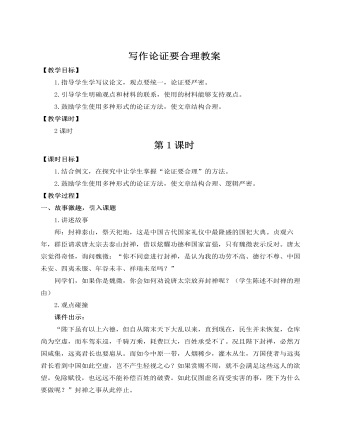
人教部编版语文九年级上册写作论证要合理教案
当然,知足常乐者,并不是说这个人要安于现状,没有追求,没有理想,而是要懂得适可而止,懂得取舍,懂得放弃,毕竟人的欲望是无限的。如《我的叔叔于勒》讲述了这样一个故事:年轻时,于勒大肆挥霍,被看成是“祸水”,落得被扫地出门的地步。既至美洲,赚了小钱,两年后又发了大财,成为大家的“福星”。菲利普一家渴盼有钱的于勒归来,二姐也因此找到了未婚夫,一家人都很高兴,出国到哲尔赛岛旅行。他们在船上却见到一个酷似于勒的穷苦的卖牡蛎的人,菲利普先生在船长那里得到了可怕的印证。不但发财的梦想化为乌有,进入上流社会的美梦成为泡影,而且眼下二女儿的婚事也岌岌可危,最后全家不动声色地改乘另一艘海轮回来。菲利普夫妇对于勒的态度完全建立在金钱之上,因此,他们的人生注定不会常乐。被称为“古今隐逸诗人之宗”的陶渊明,在乡野山林中,找到了人生乐趣。大名鼎鼎的诗仙李白,在不得志之时,仍有“天生我材必有用,千金散尽还复来”的达观之句。被林语堂先生称为“无可救药的乐天派”的苏东坡虽一生坎坷,仍对生命和生活充满热爱。所以,知足者,常乐也。人们常说:“人生不如意事十之八九。”那么我们不妨“常想一二”。拥有一颗乐观的心,才是我们成功的关键。

人教部编版语文九年级上册写作议论要言之有据教案
分析是联系论据与论点的桥梁,是丰富文章内容的关键所在。有了分析,事例和论点就能成为有机的统一体;只有通过理性的分析,剖析出事例与论点之间的关系,才能让文章拥有令人信服的逻辑力量。总结:运用论据的时候,对论据进行适当的变化、概括、分析,要有重点、有意识地突出所述事实论据和观点一致的地方,保证所述事实与观点相对应。可参照“分论点+事例+对事例进行分析+结论(照应分论点)”这样的格式来进行论证。【设计意图】以学生小组讨论来得出运用论据的三个方法 ,让学生自己在交流讨论中品味体验。通过“讨论”“交流”等形式实现学生的自主学习,达到培养学生独立思考能力和写作表达能力的目的。五、品读例文,评点“言之有据”1.根据文题,画思维导图课件出示:《论语·为政》中说:“人而无信,不知其可也。”诚信,自古以来就是一种美德。欺诈、造假等不讲诚信的现象历来为人们所深恶痛绝。请以《谈诚信》为题,尝试画一个议论文的思维导图。

人教版新目标初中英语七年级上册Can you play the guitar教案
本单元主要是学习情态动词can的肯定句、否定句、一般疑问句,肯定与否定回答,以及特殊疑问句的构成和用法;复习what弓!导的特殊疑问句。本单元主要围绕“加人俱乐部,谈论自己的能力”这一话题,设计了三个任务型活动:任务一是:自己的才艺表演,学习情态动词can的用法;任务二是:自己建立俱乐部,运用情态动词can谈论自己在某一方面的能力、喜好和意愿;任务三是:我能成功,主要是复习巩固谈论各自的爱好和特长的方法。单元知识系统(树)Can you/he/she/you dance? 一Yes,I/he/she/we can./No,I/he/she/we can’t.Can Bill play the guitar?一Yes,he can,but he can’t sing.单元总体目标通过学习情态动词can的用法,使学生能够表达自己在某一方面所具备的才能;能够谈论自己的喜好与意愿;能够为自己成立的各种俱乐部制作海报;会写招聘广告。单元重难点一览重点 难点I.复习词汇:can,play,want2.词汇:guitar, dance, swim,sing, chess, speak, drum,trumpet,violin,play the guitar3.句型:Can you/he/she/you dance?Yes,I/he/she/we can./No,I/he/she/we can’t.Can Bill play the guitar?

人教版新目标初中英语七年级上册Do you want to go to a movie教案
讨论喜欢的影视类型及理由:在看过一部影视作品后,大家总是喜欢在一起谈论影视的主要内容、主要情节、主要演员主题歌曲、主题音乐等,互相介绍自己对该影视的看法。教师可以组织一次活动,分组讨论学生喜欢看什么类型的电影,并说明喜欢的理由。运用I like…I don’t like…Because it is…等语言结构;然后每个组选派一名代表向全班学生阐述本组组员喜欢观看的电影类型;最后汇总,总结出全班同学最喜欢观看哪一种类型的电影。如果有可能,根据学生的选择放一部(一段)这种类型的影视节目。通过学生的讨论、调查,使他们在完成任务的过程中学会询问和陈述自己或别人在影视方面的喜好及理由,更好地巩固所学内容。Self Check教学内容Self Check(教材P58)教学目标知识与能力复习词汇go,movie,action,comedy,documentary,thriller,and,but,scary,funny, sad,exciting;引导学生复习、巩固“制订计划和打算并谈论喜好和偏爱”的目标语言。

人教版新目标初中英语七年级上册What time do you go to school教案
知识与能力复习词汇time,morning,breakfast,get up,g0 t0 bed,homework,clock,afternoon,lunch,run,watch TV,evening,dinner,eat,usually,o’clock,thirty,fifteen,take a shower,go t0 school等;引导学生复习、巩固“询问和谈论时间”的目标语言并运用所学知识安排自己的学习和课外活动。过程与方法运用Summarizing,Classifying和Comparing的学习策略。在复习教学中,运用听写、提问、对话演练与调查活动,促使学生不断地使用所学内容,从而提高他们灵活运用知识的能力。情感态度价值观本部分的主要内容是复习“日常作息时间”的询问和表达。通过互相询问或谈论自己或对方的作息时间安排和活动计划,培养学生良好的作息习惯和守时习惯。教学重、难点及教学突破重点复习词汇time,morning,breakfast,get up,g0 to bed,homework,clock,afternoon,lunch,run,watch TV,evening,dinner,eat,usually,o’clock,thirty,fifteen,take a shower,go to school等;引导学生复习、巩固“询问和谈论时间”的目标语言。

人教版新目标初中英语七年级上册What’s this in English教案
一、知识和能力目标本单元的核心教学内容是“认物”。用英语确认周围的常见事物比较符合英语初学者的实际情况。通过本单元教学,使学生运用所学句型,去熟悉周围事物的名称;教学生学会在实际生活中如何确认事物。通过辨认物体,学生学到一些生词,并巩固所学句型。二、过程和方法目标教师要尽量使学生对课文中出现的句型能够熟练上口,这样,学生才能顺利开展比较灵活的对话。教师可以用手势,表情,动作等示意,帮助学生听懂课堂教学内容,但在实际操作中应尽量避免“明知故问”的倾向,应该采用应用性原则;如:遮盖物品、显露局部、辨认物体、完形识别、图形辨认等方法。三、情感态度和价值观目标目标在学生学习过程中的作用至关重要,教师要帮助他们建立起一个切合自己实际的目标,通过渐进的学习以及一点一滴的进步,使他们逐步建立起成功感。成功越多,自信心就越强。

人教版新目标初中英语八年级上册Can you come to my party教案3篇
Step 3 (3b)First, tell the students when we talk about our future plans, we often use: I’m+verb+ing When we talk about what we must do, we use have to. Ask the students to fill in the blanks in 3b. The answers are: shopping, go to see, a test, I’m going, my family. Step 4 (3c)Let the students write an e-mail message to a friend. Say why you can’t visit next. Before the exercise, ask the students to give some possible answers and write them on the blackboard. So the students will feel easy to finish the writing exercise. After they finish it, Let them to correct it in groups first. Each group chooses theirs best one to read in front of the whole class. Step 5 ( planning a party )First read the conversation in the box together. Then ask the students to turn to page 88.Write down everything you have to do next week. Write in all the things you have to do . Ask the students to look at the list. Ask them “What day are you free?” This is when you can have your party. Step 6 (Self check 1 )Let the students to fill in the blanks with the words given. Change the forms of the words if possible. Then make their own sentences. The answers are: visit, playing, have to, study, comeStep 7 (Self check 2)Imagine you are Marie. Read the information and look at your schedule. Write replies to the invitation.

人教版新目标初中英语八年级上册How do you make a banana milk shake教案2篇
1. First, ... then, ... next, ... finally, ...首先,……然后,……接着,……最后,……这是英语中表达做某事的步骤的一种说法。如果步骤较多,还可以说:first-next-after that-later on-finally/at last通常你会听到说英语国家的人在说 first, next, then, finally 和后面的内容时,他们会做一些停顿。这样就能提前告诉听者接下来讲的是一系列的步骤。这一点在朗读和听力中应特别注意。2. how many, how much均为疑问词,同是“多少”,但用法不同。请看:how many修饰可数名词复数,how much修饰不可数名词。但在用法上,同学们常犯如下错误:1) [误] How many are there bananas on the table?[正] How many bananas are there on the table?[析] how many, how much 中的many,much是形容词,常修饰名词作定语,故后面跟名词。2) [误]How much tea are there on the table?[正]How much tea is there on the table?[析] how much修饰不可数名词时,谓语动词用单数。how many与how much的区别可简记为:前how many:问“多少”,复数名词后面跑;how much问“多少”,不可数名词单数好。前者答语用基数词,后者答语用数量关系。

人教版新目标初中英语八年级上册Could you please clean your room教案3篇
一、 教学内容Section A 1a----1c二、 教学目标1.学习词汇do the dishes, make the bed, take out the trash, fold the clothes, do the laundry, sweep the floor, clean the living room.2.句型 Could you please clean your room? Yes, sure.三、 教学准备 学生预习本单元所有的词汇多媒体课件 活动表 奖品四、 教学过程Pre-task1. Warming upEnjoy ourselves. Watch cartoon Cinderella. 看动画片段《灰姑娘》导如入本课话题和新词汇“chores”美丽善良的鬼姑娘因继母的嫉妒,每天得做所有的家务。片段的主题使学生联想到本课的话题。2. learn new words and phrasesLook! What is she / he dong? 看图学习动词词组do chores, do the dishes, make the bed, take out the trash, fold the clothes, do the laundry, clean the living room.3. Guessing game.What is she doing ? 4. Pair work. 1a, Do you do these things at home? Write “Y” for “yes” and “N” for “no”.5. Listening . 1b , Peter’s chores or Mom’s chores?理解目标语Could you please clean your room? Yes, sure.Write “M” for Mom’s chores, “P” for Peter’s chores in the chart.6. PairworkLook at the picture,Ask your partner to do the chores that you see. 7. Interview Who is the most able at home? 1) What chores do you do at home? How often do you do the chores? Work in four, interview each of the students in the group, fill in the chart.

人教版新目标初中英语八年级上册What are you doing for vacation教案2篇
Teaching goals : 1. Words & phrases: babysit ,get back , fishing , rent , think about , decide(on) , tourist etc. 2. How to talk about future plans . 3. 现在进行时表示将来计划或行动. 4. 特殊疑问句(where , when , how long引导) Important and difficult points : Drills :What are you doing for vacation ? I’m watching TV . When are you going ? I’m going … . How long are you staying ? We’re staying for five days . Teaching aids : cards and a tape ,a large wall calendar . Period 1 Teaching procedures : Step 1Leading in1. Free talk . 2. Put up the wall calendar . T: I’m staying home on Saturday (pointing to next Saturday ).Ss repeat . Ss: I’m staying home on Saturday . T: OK. Today we’ll learn how to talk about future plans. Step 2Pre-task SB Page 13 , 1a . 1. Look at the picture carefully and tell what you see in the picture . 2. Write the activities from the pictures in the box and add some more . 3. Practice reading . Step 3While-task1. Using the activities we write in 1a to make conversations .For example :What are you doing for vacation ? I’m visiting my uncle . 2. Pairwork .Practice in pairs . 3. 用第三人称练习对话.

人教版新目标初中英语八年级上册What’s the best radio station教案2篇
教学重点和难点:运用所掌握的语言描述,比较不同地点的特点。在练习中学习掌握英语比较级和最高级的用法。课前准备分配小组,每组五至六人。通过上网或翻阅报刊杂志等方法,确定旅游线路,做出基本的旅游计划。教学设计:本节课流程图 学法指导:1.由于这是一堂新课,在教学中应注意面向全体,发挥学生的主体性,引导学生积极参与,激发学生的求知欲和学习积极性,指导学生积极思维,主动获取知识,养成良好的学习方法。逐步学会独立解决问题。总之要尽可能调动学生的非智力因素促进智力因素的发展。教法选择:1.电化教学法2.课堂讨论法3.任务型教学法采用这些方法的目的是为了充分调动学生的学习积极性,使学生变被动学习为主动学习。通过电脑形象的演示,加强印象,提高兴趣,突破难点,提高教学效率,进而增大教学的容量和信息量。充分体现教师为主导,学生为主体的教学原则。

人教版新目标初中英语八年级上册What’s the matter教案2篇
She shouldn’t go to the party tonight.Step7. TaskT: You know, there are lots of problems in our life. If you are a doctor, please tell us how to solve the problem. I will divide you into 9 groups. Please work in groups. And then choose one of you to report your ideas.The following are the problems:I have a toothache.I am hungry. I have a sore throat.I am stressed out. I have a sore back.I am tired. I can’t sleep.I have a cold. I have a headache.Report: If you have a headache, you should go to bed early. You should see the doctor. You should eat some medicine. You shouldn’t wash your face with cold water.You shouldn’t sleep late.You shouldn’t swim.…..T encourages the students to give advice as much as possible.Homework:1. Chose one of the problems, and write down your advice2. Copy the new words这一步是用于热身的,同时也可以让他们复习一部分的表示人体部位的单词,扩充知识.学习语言的过程也是一个不断积累的过程,复习旧知识,增添新知识.通过小游戏,强化学生对Does she/he have…这个句子的运用能力.通过复习,自然的引到下面新知识的学习。充分利用表格,由句子到对话,再到文章,让学生循序渐进. 提高学生的综合语言运用能力,运用以前学过的知识来解决身边的问题.Period 5 (Section B 3a—3c, selfcheck)教学内容与分析:

人教版新目标初中英语九年级上册Teenagers should be allowed to choose their own clothes教案2篇
Step 1 Greeting Greet the class and check the homeworkStep 2 A duty report The S on duty gives a report on the rules in his home and lead in 3a “Sun Fei’s and Wu Yu’s rules” Step 3 ReadingSs read the conversation and write the two girls’ rules in the chart. Check the answers.Get Ss to read after the tape and then read aloud by themselves. Then, T explains the language points.Step 4 Pairwork 3bRole play. Use the information in chart to practice with the conversation in 3a covered. They can look at the sample conversation in the right box.Step 5 Task 2 “Who’s the best reporter?”Make a survey by asking any 5 students the questions in the chart in activity 4. Then give out a report about it. See who is the best reporter? And the best reporter will get a nice ball-pen.Step 6 Summary and homework:Write out the report in your exercise-books.Period ThreeStep 1 Greeting and a duty reportThe S gives a duty report talking about his experience of being late for school. Lead in the question “Do you ever get to school late? How often do you get to school late? Always, usually, sometimes, or never?Step 2 1a Get Ss to finish writing.Step 3 Pairwork 1b Get Ss to talk about their answers with their partners using the sample conversation in the box on the right.Step 4 Listening practice2a Lead-in: What will happen if you get to school late? What about Peter? Let’s listen to a conversation between Peter and his father. Get Ss to finish 2a (As usual, for the first time, Ss only listen.) Check the answers.

人教版新目标初中英语九年级上册How do you study for a test教案2篇
内容提示本单元主要内容是学会利用verb十by/with gerund表示方式方法来讨论学习英语的策略,认识自己在学习方面的长处和不足。初步了解现在完成时的结构和用法。现在完成时由助动词have/has+动词的过去分词构成,主要表示过去发生的某一动作对现在仍有影响或造成的后果,常与already,yet,just,ever,never等副词连用。教学目标一、学习目标(Language Goal) 1. Talk about how to study . 学会讨论各种学习方法和策略。2. Find out your suitable learning methods. 找出适合自己的学习方法。 二、语言结构(Language Structures) 1. Verb + by with gerund by+动名词短语 表示“通过…途径,方法” 2. How questions have引导的特殊疑问句 三、目标语言(Target Language) 1. How do you study for tests ? 你是怎样准备考试的?Well , I study by working with my classmates. 哦,我和同学们一起学习。2. Have you ever studied with a group ? 你曾经参加过学习小组吗?Yes , I have . I’ve learned a lot that way . 是的,参加过。通过这种方式我学了许多。

人教版新目标初中英语九年级上册Where would you like to visit教案2篇
The First PeriodⅠ.Teaching Aims and DemandsKnowledge Objects(1) Key Vocabularytiring, educational, fascinating, thrilling, peaceful, exotic, trek, jungle, take it easy, explore, historic, site(2) Target LanguageWhere would you like to go on vacation?I’d like to trek through the jungle, because I like exciting vacations.2. Ability Objects(1)Train students to talk about places they would like to visit with the target language.(2)Train students to describe vacations with different adjectives.(3)Train students' listening skill.3. Moral Object,It′s more interesting to go on vacating somewhere instead of staying at home.Ⅱ. Teaching Key Points1. Key Vocabularytiring, educational, fascinating, thrilling, peaceful, exotic, trek, jungle, take it easy, explore, historic, site2. Target LanguageTalk about different places with the target language.Ⅲ. Teaching Difficult Points1. Describe vacations with different adjectives.2. Talk about different places with the target language.Ⅳ. Teaching Methods1. Teaching by illumination2. Teaching by doing chain drills3. Teaching by pairworkⅤ. Teaching Aids1. A tape recorder2. Some pictures of different places with famous views
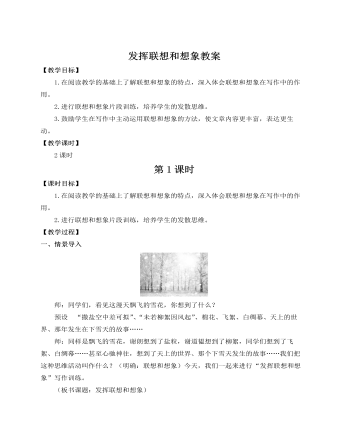
人教部编版七年级语文上册发挥联想和想象教案
【设计意图】本环节是为了突破难点而设计,以名篇佳作为范例,引导学生理解什么叫作合理而大胆的想象,示范作用明显。另外,本环节也是为下一环节——学生自由想象自己十年后的生活做铺垫。三、写作实践师:同学们,让我们拿起笔,徜徉于联想和想象的世界。1.学生写作课件出示:题目:你有没有憧憬过未来的生活?你觉得,十年以后的你是什么样子的呢?在做什么?又有着怎样的精神面貌呢?请以《十年后的我》为题,发挥想象,写一篇作文。不少于500字。思路点拨:发挥大胆而丰富的想象,可从十年后的生活变化、社会发展变化等方面着手,塑造人物的变化,如人物的相貌、心态及性格等,但性格的发展一定要符合逻辑。写法指导:选择一件事或几件事,通过语言、动作等描写来展现人物的性格。写作中也可采用前后对比的手法,如现在的“我”性格暴躁,十年后的“我”性格温顺等,通过人物的变化来反映社会的变化。
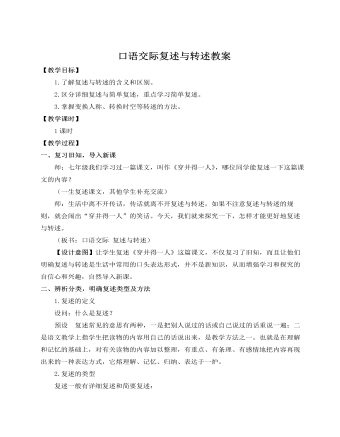
人教部编版语文八年级上册口语交际复述与转述教案
五、加工信息,学会表述师:请同学们阅读课本P122第三题,用自己的话告诉同学,什么是经典。课件出示:1.经典作品是那些你经常听人家说“我正在重读……”而不是“我正读……”的书。2.经典作品是这样一些书,它们对读过并喜爱它们的人构成一种宝贵的经验;但是对那些保留这个机会,等到享受它们的最佳状态来临时才阅读它们的人,它们也仍然是一种丰富的经验。3.一部经典作品是一本每次重读都好像初读那样带来发现的书。4.一部经典作品是一本即使我们初读也好像是在重温我们以前读过的东西的书。5.一部经典作品是一本从不会耗尽它要向读者说的一切东西的书。6.经典作品是这样一些书,我们越是道听途说,以为我们懂了,当我们实际读它们,我们就越是觉得它们独特、意想不到和新颖。
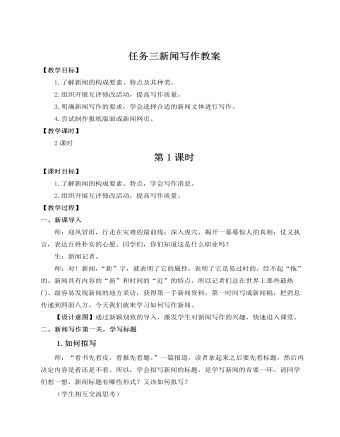
人教部编版语文八年级上册任务三新闻写作教案
五、布置作业新闻是我们了解社会、了解世界的窗口,每天都有各种各样的新闻发生。虽然新闻写作活动已经结束,但是听新闻、看新闻的活动才刚刚启幕。学了新闻写作的方法,我们再去听新闻、看新闻,就更有针对性,更能了解作者的写作意图。今天的作业比较特殊,是一个长期的作业,即希望同学们能够每天坚持至少听新闻、看新闻十分钟。结束语:同学们,明代思想家顾宪成有名联:“风声雨声读书声声声入耳;家事国事天下事事事关心。”“新闻每天发生,视角各有不同。”网络时代,我们更应该走向更广阔的世界,用一双新闻眼,发现生活中的新闻事件,传播正能量的新闻事实。这是我们的义务,也是我们光荣的责任。【设计意图】写作新闻是提升综合素质的绝佳途径之一,它让我们紧贴时代脉搏,既开阔了视野,又锻炼了思辨能力,还可以学到各种科学新知、流行文化。在学生了解了新闻写作的基本方法后,向他们提出听新闻、看新闻的要求,旨在培养他们关心时事的习惯,为他们的素养提升奠基。
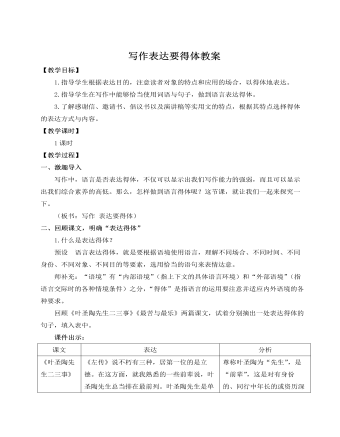
人教部编版语文八年级上册写作表达要得体教案
预设 这篇邀请函格式正确、要素齐全、语言得体。主要表现在:标题直接点明邀请的目的,清晰醒目;格式上有称呼、问候语、祝颂语、落款,符合邀请函的基本格式要求;正文中有邀请的理由,让家长明确被邀请的原因;有活动的时间、地点,以及启动仪式的流程和注意事项,让被邀请者有所了解和准备,更显真诚、有礼。整个邀请函,态度诚恳,简洁明了,表达得体。3.拓展迁移,把握书信体应用文写作格式师:请同学们探讨一下,采用书信格式写作的应用文还有哪些?它们的共同点是什么?预设 感谢信、慰问信、表扬信、申请书(请假条)、倡议书、介绍信、证明信、求职信、应聘信、祝贺信、请柬等。格式一般由六个部分构成,即标题、称呼、问候语、正文、祝颂语、落款。








